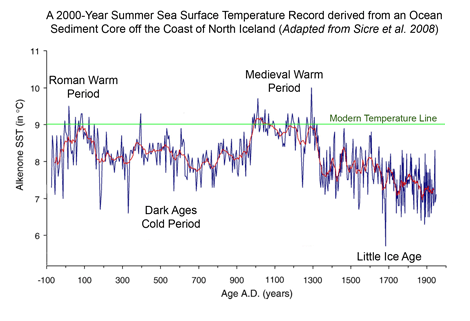Reference
Sicre, M.-A., Jacob, J., Ezat, U., Rousse, S., Kissel, C., Yiou, P., Eiriksson, J., Knudsen, K.L., Jansen, E. and Turon, J.-L. 2008. Decadal variability of sea surface temperatures off North Iceland over the last 2000 years. Earth and Planetary Science Letters 268: 137-142.
What was done
The authors developed a unique 2000-year-long summer sea surface temperature (SST) record with unprecedented temporal resolution (2-5 years) from a sediment core retrieved off North Iceland (66°33'N, 17°42W), based on their analyses of alkenones synthesized primarily in the summer by the marine alga Emiliania huxleyi that grew in the overlying ocean's surface waters, while dating of the SST data was provided by tephrochronology.
What was learned
The graph below is adapted from the temperature history derived by Sicre et al. Of particular interest to us is the fact it clearly reveals the millennial-scale oscillation of climate that produced the Roman Warm Period, Dark Ages Cold Period, Medieval Warm Period, Little Ice Age and Current Warm Period.

Figure 1. Sea surface temperature vs. time. Adapted from Sicre et al. (2008).
In comparing prior temperatures to those of the near-present, we note that the SST record peaks at about 8.3°C somewhere in the vicinity of 1940, which was a particularly warm time in earth's modern history. However, the researchers show a "modern temperature" of 9°C that they determined from a box-core of nearby surface sediment, which they say "is consistent with the recent compilation produced by Hanna et al. (2006)," who report that "since 1874, July and August SSTs measured at Grimsey Island have varied between 6.7 and 9°C," which ultimately suggests that Sicre et al.'s 9°C value is the peak modern temperature observed to the time of Hanna et al.'s analysis.
What it means
In light of the above observations, it can be concluded that the peak temperature of the Medieval Warm Period was fully 1°C warmer than the peak temperature of the Current Warm Period, and that the peak temperature of the Roman Warm Period was about 0.5°C warmer than that of the Current Warm Period. And since the air's CO2 concentration at those two earlier times was at least 100 ppm less than it is today, whatever caused the much higher-than-current temperatures of those earlier warm periods may well be what has caused the more modest high temperatures the earth has experienced in our day and age.
Reference
Hanna, E., Jonsson, T., Olafsson, J. and Vladimarsson, H. 2006. Icelandic coastal sea surface temperature records constructed: putting the pulse on air-sea-climate interactions in the Northern North Atlantic. Part I: Comparison with HadISST1 open-ocean surface temperatures and preliminary analysis of long-term patterns and anomalies of SSTs around Iceland. Journal of Climate 19: 5652-5666.




